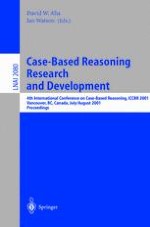The 2001 International Conference on Case-Based Reasoning (ICCBR 2001, www.iccbr.org/iccbr01), the fourth in the biennial ICCBR series (1995 in Sesimbra, Portugal; 1997 in Providence, Rhode Island (USA); 1999 in Seeon, Germany), was held during 30 July – 2 August 2001 in Vancouver, Canada. ICCBR is the premier international forum for researchers and practitioners of case based reasoning (CBR). The objectives of this meeting were to nurture significant, relevant advances made in this field (both in research and application), communicate them among all attendees, inspire future advances, and continue to support the vision that CBR is a valuable process in many research disciplines, both computational and otherwise. ICCBR 2001 was the first ICCBR meeting held on the Pacific coast, and we used the setting of beautiful Vancouver as an opportunity to enhance participation from the Pacific Rim communities, which contributed 28% of the submissions. During this meeting, we were fortunate to host invited talks by Ralph Bergmann, Ken Forbus, Jaiwei Han, Ramon López de Mántaras, and Manuela Veloso. Their contributions ensured a stimulating meeting; we thank them all.
